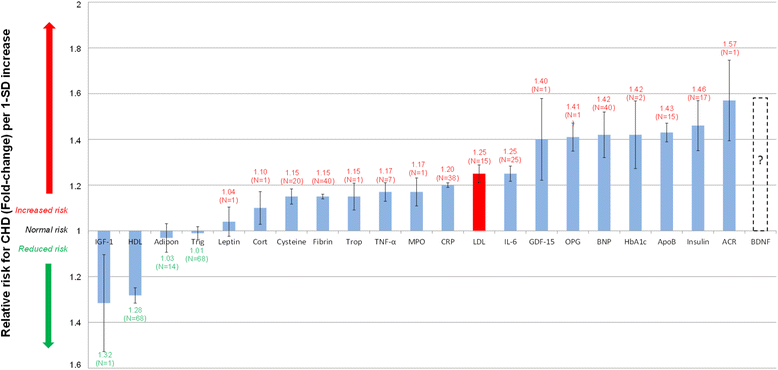The mechanism by which moderate alcohol consumption influences coronary heart disease
- PMID: 25889723
- PMCID: PMC4389579
- DOI: 10.1186/s12937-015-0011-6
The mechanism by which moderate alcohol consumption influences coronary heart disease
Abstract
Background: Moderate alcohol consumption is associated with a lower risk for coronary heart disease (CHD). A suitably integrated view of the CHD pathogenesis pathway will help to elucidate how moderate alcohol consumption could reduce CHD risk.
Methods: A comprehensive literature review was conducted focusing on the pathogenesis of CHD. Biomarker data were further systematically analysed from 294 cohort studies, comprising 1 161 560 subjects. From the above a suitably integrated CHD pathogenetic system for the purpose of this study was developed.
Results: The resulting integrated system now provides insight into the integrated higher-order interactions underlying CHD and moderate alcohol consumption. A novel 'connection graph' further simplifies these interactions by illustrating the relationship between moderate alcohol consumption and the relative risks (RR) attributed to various measureable CHD serological biomarkers. Thus, the possible reasons for the reduced RR for CHD with moderate alcohol consumption become clear at a glance.
Conclusions: An integrated high-level model of CHD, its pathogenesis, biomarkers, and moderate alcohol consumption provides a summary of the evidence that a causal relationship between CHD risk and moderate alcohol consumption may exist. It also shows the importance of each CHD pathway that moderate alcohol consumption influences.
Figures

 icon. The blunted blue arrows denote antagonise or inhibit and pointed blue arrows denote up-regulate or facilitate. HDL denotes high-density lipoprotein; LDL, low-density lipoprotein; oxLDL, oxidised LDL; FFA, free fatty acids; TMAO, an oxidation product of trimethylamine (TMA); NLRP3, Inflammasome responsible for activation of inflammatory processes as well as epithelial cell regeneration and microflora; Hs, homocysteine; IGF-1, insulin-like growth factor-1; TNF-α, tumour necrosis factor-α; IL, interleukin; NO, nitric oxide; NO-NSAIDs, combinational NO-non-steroidal anti-inflammatory drug; SSRI, serotonin reuptake inhibitors; ROS, reactive oxygen species; NFκβ, nuclear factor-κβ; SMC, smooth muscle cell; HbA1c, glycated haemoglobin A1c; P. gingivalis, Porphyromonas gingivalis; vWF, von Willebrand factor; PDGF, platelet-derived growth factor; MIF, macrophage migration inhibitory factor; SCD-40, recombinant human sCD40 ligand; MPO, myeloperoxidase; MMP, matrix metalloproteinase; VCAM, vascular cell adhesion molecule; ICAM, intracellular adhesion molecule; CRP, C-reactive protein; PAI, plasminogen activator inhibitor; TF, tissue factor, MCP, monocyte chemoattractant protein; BDNF, brain-derived neurotrophic factor; PI3K, phosphatidylinositol 3-kinase; MAPK, mitogen-activated protein (MAP) kinase; RANKL, receptor activator of nuclear factor kappa-beta ligand; OPG, osteoprotegerin; GCF, gingival crevicular fluid; D-dimer, fibrin degradation product D; BNP, B-type natriuretic peptide; ACE, angiotensin-converting-enzyme; COX, cyclooxygenase; β-blocker, beta-adrenergic antagonists.
icon. The blunted blue arrows denote antagonise or inhibit and pointed blue arrows denote up-regulate or facilitate. HDL denotes high-density lipoprotein; LDL, low-density lipoprotein; oxLDL, oxidised LDL; FFA, free fatty acids; TMAO, an oxidation product of trimethylamine (TMA); NLRP3, Inflammasome responsible for activation of inflammatory processes as well as epithelial cell regeneration and microflora; Hs, homocysteine; IGF-1, insulin-like growth factor-1; TNF-α, tumour necrosis factor-α; IL, interleukin; NO, nitric oxide; NO-NSAIDs, combinational NO-non-steroidal anti-inflammatory drug; SSRI, serotonin reuptake inhibitors; ROS, reactive oxygen species; NFκβ, nuclear factor-κβ; SMC, smooth muscle cell; HbA1c, glycated haemoglobin A1c; P. gingivalis, Porphyromonas gingivalis; vWF, von Willebrand factor; PDGF, platelet-derived growth factor; MIF, macrophage migration inhibitory factor; SCD-40, recombinant human sCD40 ligand; MPO, myeloperoxidase; MMP, matrix metalloproteinase; VCAM, vascular cell adhesion molecule; ICAM, intracellular adhesion molecule; CRP, C-reactive protein; PAI, plasminogen activator inhibitor; TF, tissue factor, MCP, monocyte chemoattractant protein; BDNF, brain-derived neurotrophic factor; PI3K, phosphatidylinositol 3-kinase; MAPK, mitogen-activated protein (MAP) kinase; RANKL, receptor activator of nuclear factor kappa-beta ligand; OPG, osteoprotegerin; GCF, gingival crevicular fluid; D-dimer, fibrin degradation product D; BNP, B-type natriuretic peptide; ACE, angiotensin-converting-enzyme; COX, cyclooxygenase; β-blocker, beta-adrenergic antagonists.

Similar articles
-
The integrated effect of moderate exercise on coronary heart disease.Cardiovasc J Afr. 2017 Mar/Apr 23;28(2):125-133. doi: 10.5830/CVJA-2016-058. Epub 2016 Dec 12. Cardiovasc J Afr. 2017. PMID: 27942693 Free PMC article. Review.
-
Alcohol consumption, alcohol dehydrogenase and risk of coronary heart disease in the MONICA/KORA-Augsburg cohort 1994/1995-2002.Eur J Cardiovasc Prev Rehabil. 2007 Dec;14(6):769-74. doi: 10.1097/HJR.0b013e328270b924. Eur J Cardiovasc Prev Rehabil. 2007. PMID: 18043297
-
How do high glycemic load diets influence coronary heart disease?Nutr Metab (Lond). 2015 Mar 8;12:6. doi: 10.1186/s12986-015-0001-x. eCollection 2015. Nutr Metab (Lond). 2015. PMID: 25774201 Free PMC article.
-
Oral health and coronary heart disease.BMC Oral Health. 2016 Nov 15;16(1):122. doi: 10.1186/s12903-016-0316-7. BMC Oral Health. 2016. PMID: 27846870 Free PMC article.
-
Alcohol and cardiovascular disease--more than one paradox to consider. Average volume of alcohol consumption, patterns of drinking and risk of coronary heart disease--a review.J Cardiovasc Risk. 2003 Feb;10(1):15-20. doi: 10.1097/01.hjr.0000051961.68260.30. J Cardiovasc Risk. 2003. PMID: 12569232 Review.
Cited by
-
Review on Clinical Trials of Black Seed (Nigella sativa ) and Its Active Constituent, Thymoquinone.J Pharmacopuncture. 2017 Sep;20(3):179-193. doi: 10.3831/KPI.2017.20.021. Epub 2017 Sep 30. J Pharmacopuncture. 2017. PMID: 30087794 Free PMC article. Review.
-
Elevated C-Reactive Protein in Alzheimer's Disease Without Depression in Older Adults: Findings From the Health and Retirement Study.J Gerontol A Biol Sci Med Sci. 2022 Apr 1;77(4):673-682. doi: 10.1093/gerona/glab282. J Gerontol A Biol Sci Med Sci. 2022. PMID: 34671810 Free PMC article.
-
Elevated inflammation in association with alcohol abuse among Blacks but not Whites: results from the MIDUS biomarker study.J Behav Med. 2018 Jun;41(3):374-384. doi: 10.1007/s10865-017-9905-4. Epub 2017 Dec 11. J Behav Med. 2018. PMID: 29230616 Free PMC article.
-
Sustained heavy drinking over 25 years is associated with increased N-terminal-pro-B-type natriuretic peptides in early old age: Population-based cohort study.Drug Alcohol Depend. 2020 Jul 1;212:108048. doi: 10.1016/j.drugalcdep.2020.108048. Epub 2020 May 13. Drug Alcohol Depend. 2020. PMID: 32450480 Free PMC article.
-
The integrated effect of moderate exercise on coronary heart disease.Cardiovasc J Afr. 2017 Mar/Apr 23;28(2):125-133. doi: 10.5830/CVJA-2016-058. Epub 2016 Dec 12. Cardiovasc J Afr. 2017. PMID: 27942693 Free PMC article. Review.
References
Publication types
MeSH terms
Substances
LinkOut - more resources
Full Text Sources
Other Literature Sources
Medical

